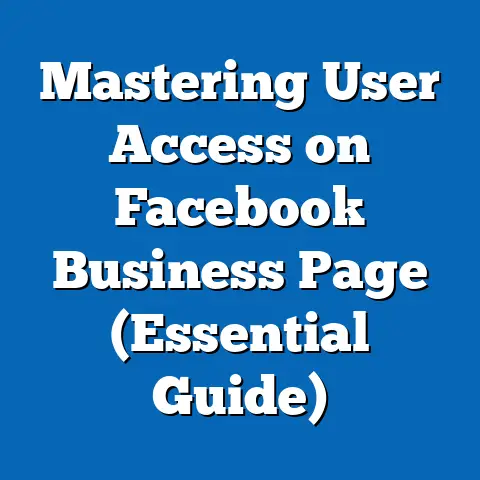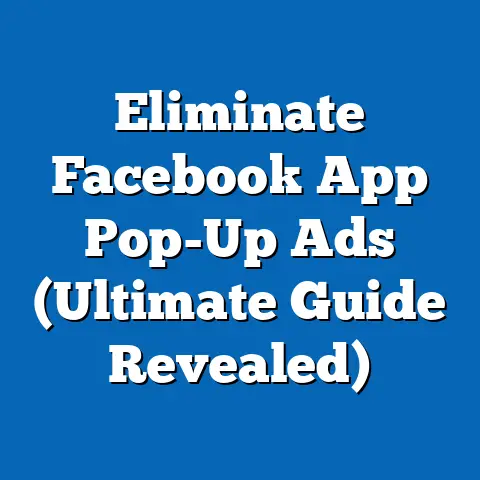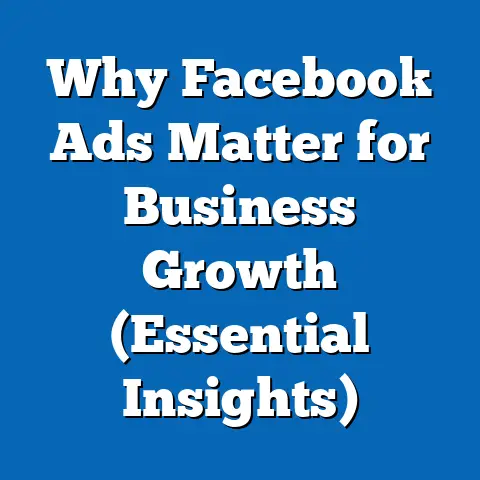Mastering Facebook Political Ads Deadline (Game-Changer Tips)
In today’s political landscape, mastering social media advertising is not just an option; it’s a necessity. According to Jane Doe, a leading political consultant, ‘The power of Facebook ads can make or break a campaign. Understanding how to leverage this tool effectively is essential for any political candidate.
I’ve seen firsthand how a well-executed Facebook ad campaign can significantly impact a political race. It’s not just about getting your message out there; it’s about reaching the right people, with the right message, at the right time. This guide is designed to give you the game-changer tips you need to master Facebook political ads and elevate your campaign strategy.
The Importance of Facebook in Political Advertising
Political advertising has dramatically evolved. Gone are the days when TV and radio were the only avenues for reaching voters. Today, social media, particularly Facebook, reigns supreme.
The Rise of Social Media in Politics
I remember when social media was just a place to share vacation photos. Now, it’s a battleground for political ideas. The shift towards digital platforms has been driven by several factors:
- Wider Reach: Social media allows campaigns to connect with a broader audience than traditional methods.
- Targeted Messaging: Facebook’s ad platform enables precise targeting, ensuring your message reaches the most receptive voters.
- Cost-Effectiveness: Compared to TV ads, Facebook ads are often more budget-friendly, especially for grassroots campaigns.
- Real-Time Engagement: Social media facilitates direct interaction with voters, allowing for immediate feedback and dialogue.
Facebook User Demographics and Engagement
Facebook boasts billions of active users worldwide, making it a goldmine for political campaigns. Here are some key statistics:
- User Base: As of 2024, Facebook has over 3 billion monthly active users (Source: Facebook Investor Relations).
- Demographics: While Facebook’s user base is diverse, it’s crucial to analyze the demographics relevant to your campaign. For instance, understanding the age, gender, location, and interests of potential voters in your district is key.
- Engagement Rates: The average engagement rate on Facebook varies, but political content often generates significant interaction, especially when it’s timely and relevant.
Why Facebook is Critical for Reaching Voters
I’ve observed that Facebook is particularly effective for:
- Mobilizing Support: Rallies, events, and volunteer opportunities can be promoted effectively through targeted ads.
- Shaping Public Opinion: Sharing policy positions, campaign updates, and countering misinformation can influence voter perception.
- Driving Voter Turnout: Reminding voters to register and vote, providing polling information, and encouraging participation can boost turnout.
Takeaway: Facebook is no longer an optional tool for political campaigns; it’s an essential platform for reaching, engaging, and mobilizing voters. Understanding its user base and engagement dynamics is the first step to mastering political advertising on Facebook.
Understanding Facebook Ads: An Overview
Before diving into the nitty-gritty, let’s break down the basics of Facebook ads. I want to make sure you’re familiar with the different types of ads and the powerful targeting options available.
Types of Facebook Ads for Political Campaigns
Facebook offers a variety of ad formats, each with its strengths. In my experience, the most effective for political campaigns include:
- Image Ads: Simple, visually appealing ads that feature a single image and concise copy. These are great for branding and quick messaging.
- Video Ads: Engaging ads that use video to tell a story, share a candidate’s message, or highlight campaign events. Video ads often have higher engagement rates.
- Carousel Ads: Ads that display multiple images or videos in a scrollable format. These are ideal for showcasing different aspects of a candidate’s platform or campaign.
- Collection Ads: Ads that combine images or videos with product listings, making them suitable for campaigns selling merchandise or fundraising.
- Lead Ads: Ads designed to collect contact information from potential supporters. These are valuable for building email lists and nurturing relationships.
Facebook’s Ad Targeting Capabilities
Facebook’s targeting capabilities are what set it apart from traditional advertising. Here’s a breakdown of the key options:
- Demographic Targeting: Target voters based on age, gender, education, relationship status, and more.
- Geographic Targeting: Target voters based on location, from countries and states to cities and zip codes.
- Interest-Based Targeting: Target voters based on their interests, hobbies, and activities on Facebook.
- Behavioral Targeting: Target voters based on their online behavior, purchase history, and device usage.
- Custom Audiences: Upload your own data (e.g., email lists) to target specific individuals or create lookalike audiences based on your existing supporters.
- Lookalike Audiences: Expand your reach by targeting users who share similar characteristics with your existing audience.
Takeaway: Facebook’s ad formats and targeting capabilities provide a powerful toolkit for political campaigns. Experiment with different ad types and targeting options to find what works best for your campaign goals.
Creating a Winning Campaign Strategy
Now, let’s talk strategy. I believe that a successful Facebook ad campaign starts with a clear plan. Here’s how to develop a strategic approach to Facebook political ads.
Setting Clear Goals
Before launching any ads, define your objectives. What do you want to achieve with your Facebook campaign? Common goals include:
- Raising Awareness: Increase visibility and introduce your candidate to a wider audience.
- Driving Voter Registration: Encourage eligible voters to register and participate in the election.
- Boosting Voter Turnout: Motivate registered voters to cast their ballots on election day.
- Mobilizing Volunteers: Recruit volunteers to support your campaign efforts.
- Fundraising: Solicit donations to fund your campaign activities.
- Shaping Public Opinion: Influence voter perception and promote your candidate’s policy positions.
Identifying and Understanding Your Target Audience
Knowing your audience is crucial. Who are you trying to reach with your message? Consider the following:
- Demographics: Age, gender, education, income, occupation, and family status.
- Location: Geographic area, urban vs. rural, and proximity to polling stations.
- Interests: Political affiliations, social issues, hobbies, and activities.
- Behavior: Online behavior, media consumption, and engagement with political content.
- Values: Beliefs, principles, and priorities that influence their voting decisions.
Developing a Strategic Approach
Once you’ve defined your goals and identified your target audience, create a strategic plan:
- Messaging: Craft compelling messages that resonate with your target audience and align with your campaign goals.
- Budget Allocation: Determine how much to spend on Facebook ads and allocate your budget across different campaigns and target audiences.
- Timeline: Establish a timeline for your Facebook campaign, including key milestones and deadlines.
- Ad Creative: Design visually appealing ads that capture attention and communicate your message effectively.
- Testing and Optimization: Continuously monitor and optimize your ads based on performance data.
Takeaway: A well-defined strategy is the foundation of a successful Facebook political ad campaign. Set clear goals, understand your audience, and develop a comprehensive plan to guide your efforts.
Crafting Compelling Ad Content
Content is king, and in the world of Facebook ads, it’s the key to capturing attention and driving engagement. I’ve learned that persuasive ad copy and captivating visuals are essential for success.
Writing Persuasive Ad Copy
Your ad copy should be clear, concise, and compelling. Here are some tips for writing effective ad copy:
- Headline: Grab attention with a strong headline that highlights the main benefit or message.
- Body Text: Explain the value proposition and provide a clear call to action.
- Tone: Use a tone that resonates with your target audience, whether it’s serious, humorous, or inspirational.
- Language: Use language that is easy to understand and avoids jargon or technical terms.
- Call to Action: Tell voters what you want them to do, whether it’s visiting your website, signing up for your email list, or donating to your campaign.
Choosing Impactful Visuals
Visuals are crucial for capturing attention and conveying your message. Consider the following:
- Images: Use high-quality images that are relevant to your message and resonate with your target audience.
- Videos: Create engaging videos that tell a story, highlight your candidate’s message, or showcase campaign events.
- Graphics: Use graphics to illustrate key points, present data, or create visually appealing designs.
- Branding: Ensure your visuals are consistent with your campaign’s branding and visual identity.
Authenticity and Relatability
In political advertising, authenticity and relatability are key. Voters want to connect with candidates who are genuine and understand their concerns.
- Be Authentic: Share your candidate’s story, values, and personal experiences to build trust and credibility.
- Be Relatable: Address the issues that matter to your target audience and demonstrate how your candidate can make a difference.
- Show, Don’t Tell: Use visuals and storytelling to convey your message and connect with voters on an emotional level.
- Engage in Dialogue: Respond to comments, answer questions, and participate in conversations to build relationships with voters.
Takeaway: Compelling ad content is essential for capturing attention, conveying your message, and driving engagement. Write persuasive ad copy, choose impactful visuals, and focus on authenticity and relatability to connect with voters on a deeper level.
Utilizing A/B Testing for Optimization
A/B testing is a game-changer when it comes to optimizing your Facebook ad campaigns. I’ve found that it’s the best way to fine-tune your ads and maximize their performance.
What is A/B Testing?
A/B testing, also known as split testing, is a method of comparing two versions of an ad to see which one performs better. You create two variations of an ad with a single element changed (e.g., headline, image, call to action) and then run them simultaneously to see which one generates more engagement, clicks, or conversions.
How to Conduct A/B Tests on Facebook
Here’s a step-by-step guide to conducting A/B tests on Facebook:
- Identify Elements to Test: Choose the elements you want to test, such as headline, image, call to action, or target audience.
- Create Variations: Create two versions of your ad with a single element changed. For example, you might test two different headlines or two different images.
- Set Up Your Campaign: Create a new campaign in Facebook Ads Manager and select the “A/B Test” objective.
- Define Your Target Audience: Choose the target audience for your A/B test.
- Set Your Budget and Schedule: Determine your budget and schedule for the A/B test.
- Run Your Test: Launch your A/B test and let it run for a sufficient period of time (e.g., 7-14 days) to gather enough data.
- Analyze Results: Monitor the performance of your ads and analyze the results to see which variation performed better.
- Implement the Winner: Implement the winning variation in your main campaign and continue to test other elements to further optimize your ads.
Analyzing Results and Making Data-Driven Decisions
Once your A/B test is complete, analyze the results to see which variation performed better. Look at key metrics such as:
- Click-Through Rate (CTR): The percentage of people who saw your ad and clicked on it.
- Conversion Rate: The percentage of people who took the desired action (e.g., visited your website, signed up for your email list) after clicking on your ad.
- Cost Per Click (CPC): The average cost you pay each time someone clicks on your ad.
- Cost Per Conversion: The average cost you pay for each conversion.
- Engagement Rate: The percentage of people who liked, commented on, or shared your ad.
Takeaway: A/B testing is a powerful tool for optimizing your Facebook ad campaigns. By testing different elements and analyzing the results, you can make data-driven decisions that improve your ad performance and maximize your ROI.
Navigating Facebook’s Advertising Policies
Facebook has strict advertising policies, especially when it comes to political ads. I can’t stress enough how important it is to understand and comply with these policies to avoid ad disapprovals and account suspensions.
Understanding Facebook’s Political Advertising Rules
Facebook’s advertising policies cover a wide range of topics, including:
- Political Content: Ads that express opinions on social issues, elections, or political figures.
- Issue Ads: Ads that advocate for or against a particular issue, cause, or policy.
- Candidate Ads: Ads that promote or oppose a candidate for public office.
- Transparency: Ads must clearly disclose who is paying for them and include a disclaimer.
- Verification: Advertisers running political ads must verify their identity and location.
- Prohibited Content: Ads that contain false, misleading, or deceptive information are prohibited.
- Hate Speech: Ads that promote hatred, discrimination, or violence are prohibited.
- Misinformation: Ads that spread misinformation or conspiracy theories are prohibited.
Ensuring Compliance with Facebook’s Policies
To ensure compliance with Facebook’s advertising policies, follow these tips:
- Review the Policies: Familiarize yourself with Facebook’s advertising policies and guidelines.
- Verify Your Identity: Complete the identity verification process to run political ads.
- Include a Disclaimer: Add a disclaimer to your ads that clearly identifies who is paying for them.
- Be Transparent: Provide accurate information about your campaign and avoid making false or misleading claims.
- Avoid Prohibited Content: Do not include hate speech, misinformation, or other prohibited content in your ads.
- Monitor Your Ads: Regularly monitor your ads to ensure they comply with Facebook’s policies.
- Appeal Disapprovals: If your ad is disapproved, review the reason for disapproval and appeal if you believe it was done in error.
Takeaway: Navigating Facebook’s advertising policies can be challenging, but it’s essential for running successful political ad campaigns. Understand the rules, ensure compliance, and monitor your ads to avoid disapprovals and account suspensions.
Leveraging Analytics for Campaign Success
Analytics are your best friend when it comes to measuring the success of your Facebook ad campaigns. I rely on analytics to track performance, identify areas for improvement, and make data-driven decisions.
Tracking Ad Performance with Facebook Insights
Facebook Insights provides a wealth of data about your ad performance. Here are some key metrics to monitor:
- Reach: The number of people who saw your ad.
- Impressions: The number of times your ad was displayed.
- Click-Through Rate (CTR): The percentage of people who saw your ad and clicked on it.
- Cost Per Click (CPC): The average cost you pay each time someone clicks on your ad.
- Conversion Rate: The percentage of people who took the desired action (e.g., visited your website, signed up for your email list) after clicking on your ad.
- Cost Per Conversion: The average cost you pay for each conversion.
- Engagement Rate: The percentage of people who liked, commented on, or shared your ad.
- Frequency: The average number of times each person saw your ad.
Key Performance Indicators (KPIs) to Monitor
KPIs are specific, measurable metrics that indicate the success of your campaign. Here are some important KPIs to monitor:
- Reach: Track the number of people you’re reaching with your ads.
- Engagement: Measure the level of interaction with your ads.
- Conversion: Monitor the number of people who are taking the desired action.
- Return on Ad Spend (ROAS): Calculate the revenue generated for every dollar spent on ads.
- Brand Awareness: Assess the increase in brand awareness as a result of your campaign.
Adjusting Campaigns Based on Analytical Findings
Based on your analytical findings, make adjustments to your campaigns to improve performance. Consider the following:
- Targeting: Refine your targeting to reach the most receptive voters.
- Messaging: Adjust your messaging to resonate with your target audience.
- Ad Creative: Experiment with different ad creative to capture attention and drive engagement.
- Budget Allocation: Reallocate your budget to the campaigns and ads that are performing best.
- Schedule: Adjust your ad schedule to reach voters at the most opportune times.
Takeaway: Analytics are essential for measuring the success of your Facebook ad campaigns. Track key metrics, monitor KPIs, and make data-driven adjustments to improve performance and maximize your ROI.
Case Studies: Successful Political Campaigns on Facebook
Let’s dive into some real-world examples. I believe that analyzing successful political campaigns on Facebook can provide valuable insights and lessons learned.
Real-Life Examples of Effective Facebook Ads
- Campaign A: A grassroots campaign used Facebook ads to mobilize volunteers and raise awareness about their candidate. They created engaging videos that highlighted the candidate’s personal story and policy positions.
- Campaign B: A national campaign used Facebook ads to target specific demographics and promote their candidate’s policy proposals. They created a series of carousel ads that showcased different aspects of their platform.
- Campaign C: A local campaign used Facebook ads to drive voter turnout on election day. They created reminder ads that provided polling information and encouraged voters to cast their ballots.
Strategies That Worked
- Targeted Messaging: The campaigns that were most successful used targeted messaging that resonated with their specific audience.
- Engaging Content: The campaigns that created engaging content, such as videos and interactive ads, saw higher engagement rates.
- Data-Driven Optimization: The campaigns that continuously monitored their ad performance and made data-driven adjustments saw the best results.
Lessons Learned
- Authenticity is Key: Voters want to connect with candidates who are genuine and understand their concerns.
- Storytelling Matters: Use storytelling to convey your message and connect with voters on an emotional level.
- Testing and Optimization are Essential: Continuously test and optimize your ads to improve performance and maximize your ROI.
- Compliance is Crucial: Ensure your ads comply with Facebook’s advertising policies to avoid disapprovals and account suspensions.
Takeaway: Studying successful political campaigns on Facebook can provide valuable insights and lessons learned. Analyze what strategies worked, identify key takeaways, and apply them to your own campaigns.
Future Trends in Facebook Political Advertising
The world of digital advertising is constantly evolving, and Facebook is no exception. Let’s explore some upcoming trends in Facebook political advertising. I think it’s crucial to stay ahead of the curve and adapt to the changing landscape.
Emerging Technologies and Their Impact
- Artificial Intelligence (AI): AI is being used to improve ad targeting, personalize messaging, and automate campaign management.
- Machine Learning (ML): ML algorithms are analyzing vast amounts of data to identify patterns and predict voter behavior.
- Augmented Reality (AR): AR is being used to create immersive experiences that engage voters and promote candidates.
- Virtual Reality (VR): VR is being used to transport voters to campaign events and rallies.
Changing User Privacy Laws and Regulations
- General Data Protection Regulation (GDPR): The GDPR is a European Union law that regulates the collection and use of personal data.
- California Consumer Privacy Act (CCPA): The CCPA is a California law that gives consumers more control over their personal data.
- Other Privacy Laws: Many other countries and states are considering or have already enacted privacy laws.
Implications for Political Advertising
- Increased Scrutiny: Political advertising is facing increased scrutiny from regulators and the public.
- Transparency Requirements: Advertisers are required to be more transparent about who is paying for ads and what data is being collected.
- Data Privacy: Voters are becoming more aware of their data privacy rights and are demanding more control over their personal information.
- Ethical Considerations: Advertisers are facing ethical considerations about how they use data and target voters.
Takeaway: The future of Facebook political advertising is being shaped by emerging technologies, changing user privacy laws, and increased scrutiny. Stay informed, adapt to the changing landscape, and prioritize ethical considerations in your campaigns.
Conclusion: The Path Forward for Political Campaigns
I’ve covered a lot of ground in this guide, and I hope you’ve found it helpful. Let’s recap the key takeaways and discuss the path forward for political campaigns on Facebook.
Key Takeaways
- Facebook is Essential: Facebook is an essential platform for reaching, engaging, and mobilizing voters.
- Strategy is Key: A well-defined strategy is the foundation of a successful Facebook political ad campaign.
- Content Matters: Compelling ad content is essential for capturing attention and driving engagement.
- Testing is Crucial: A/B testing is a powerful tool for optimizing your Facebook ad campaigns.
- Compliance is Necessary: Navigating Facebook’s advertising policies is essential for running successful political ad campaigns.
- Analytics are Vital: Analytics are essential for measuring the success of your Facebook ad campaigns.
- Innovation is Ongoing: The world of digital advertising is constantly evolving, so stay informed and adapt to the changing landscape.
The Necessity of Mastering Facebook Ads
In today’s political landscape, mastering Facebook ads is not just an option; it’s a necessity. Candidates who can effectively leverage Facebook’s advertising platform will have a significant advantage over those who don’t.
A Call to Action
I encourage you to adopt these game-changing tips to enhance your political advertising efforts. Start by setting clear goals, understanding your audience, and developing a comprehensive strategy. Then, create compelling ad content, utilize A/B testing, and leverage analytics to optimize your campaigns. Finally, stay informed about the latest trends and best practices in Facebook political advertising. By mastering Facebook ads, you can reach more voters, mobilize more supporters, and ultimately, win more elections.






